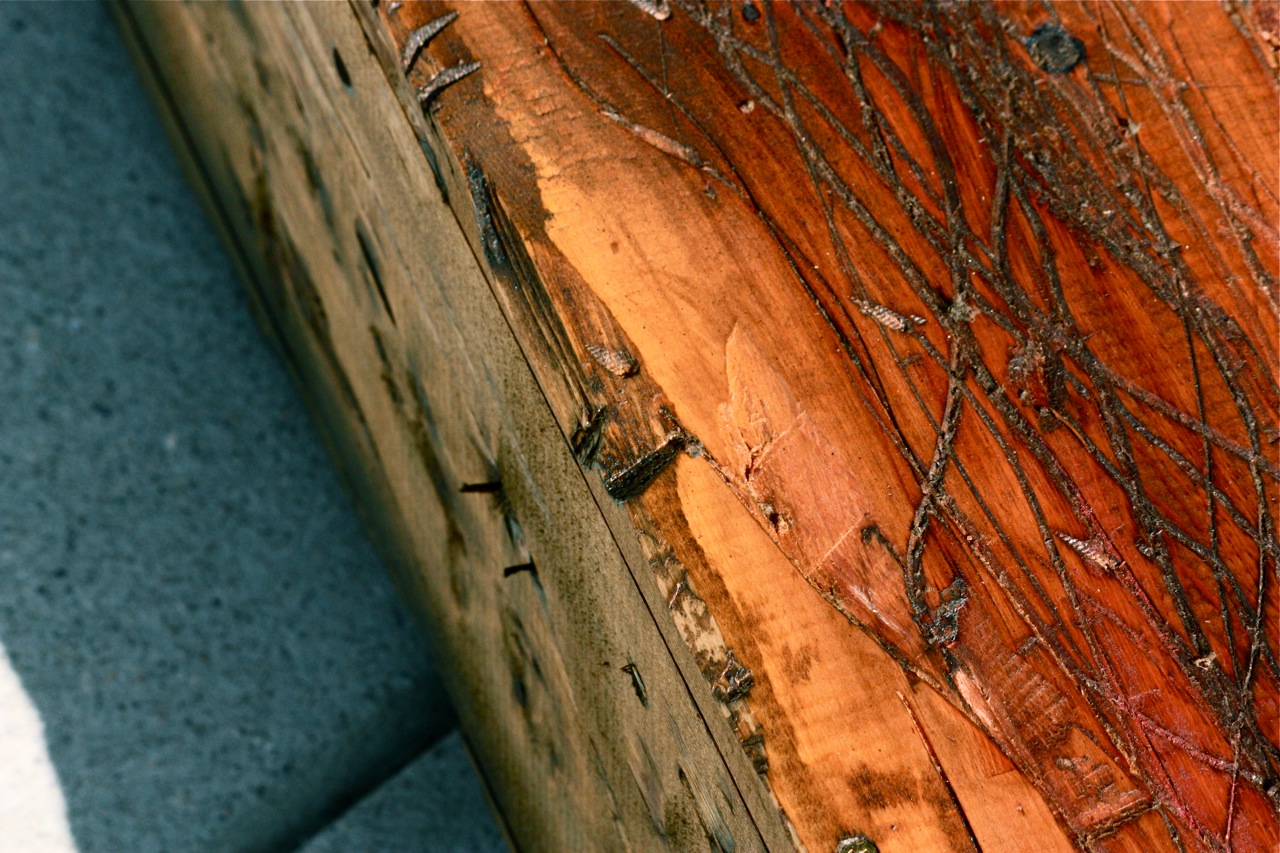A few years ago we commissioned an elderly saint in our fellowship to build us a cross. We wanted a big one, so he was forced to make it hollow so we could still raise it twenty feet in the air to display at the front of our sanctuary. He did a marvellous job, capping the stray ends before turning it over to me.
My job? To distress and stain the wood.
Right from the start I envisioned an old, rugged cross—not a pop star heirloom—so I came to work that morning armed with the merciless tools I would inflict on the unsuspecting wood. As it turns out, the wood knew the truth all along; it was I who walked into those moments unsuspecting. Here’s what happened next.
I began with a simple hammer and chisel, working from the bottom upward. It was exhausting. Twenty minutes in, I realized this project might very well take me all day. My second realization rendered the first one irrelevant: I was not just “making a cross.” This was art, a sacred invitation to express my faith visually in a way that just might impact others in our church for generations.
My heart burst into flame.
I hammered, I chiselled, I pounded and scraped and gouged and dragged, working until my back was wet and my swollen arms quivered with intensity. A vine-like tangle of markings climbed the shank of the cross as I worked.

Forty-five minutes later my third realization hit: This was not just a cross, not even just art. This was a labour of love for my Saviour. It was deeply spiritual. The bright coals of my heart, already burning fiercely, crumbled in deference to the spiking heat.
I stood back, admiring my work, catching my breath. It was lunch time. The phone in my back pocket buzzed and warbled. I didn’t care. I wanted to abide in the moment. I dove back in with new eyes, tracing the savage contours more gently, scarring the wood with a passion torn in two directions. Deeper. Deeper. My pounding reminded me of the crucifixion. It’s as if I were doing this to Jesus himself—yet I had to finish it, had to bring out the ugliness before the beauty could burst forth. Running my fingers along the wounds, I let the wood bite my own flesh.

Jesus was a carpenter by trade, before he began his ministry. Surely the wood must have spoken to him before that day.It spoke to me. The splinters hurt, but I relished the painful message. I noticed blood on my palm and I welcomed it, as if working on a cross without blood on my hands to show for it might be a kind of sacrilege. And then, suddenly, I’d finished the distressing. The scars I inflicted in the proud beams will remain as long as the wood remains, just as Christ bears his scars for me.
It was time to stain the piece. Outside.
I grunted the cross onto my back, assuming the classic pose, and the wood tore into my shoulder. I winced, then dragged it across the floor toward the door. I almost stumbled under the awkward weight, this hollow symbol carved from wood that used to be a living thing. Christ’s cross wasn’t hollow. But it wasn’t just full of wood, either. It was blood-soaked, a trillion pound anchor steeped in darkness, death, and damnation.
Outside, I plunged an old cloth into the gallon of stain and remembered my own stains, the psychic ink that made the cross inevitable for Jesus. The wood was parched, drinking in the stain like it had been waiting for this day. I began the staining carefully, but then moved more quickly as I gained confidence. The richness of the gnarled beam began to emerge through the scars. The stain splashed my arm, covered the beam, painted the asphalt beneath it. It felt like I was working with Christ’s spattered love and life on that day of days.

I had a moment of weakness then as I considered what to do with the backside of the cross. No one would see it once the piece was mounted. I considered not staining it, or perhaps just giving that portion a single coat. Thankfully, the thought of cutting corners with the cross of Jesus Christ put me to shame. I remembered my labor of love. Every square inch, no matter how invisible, would receive the same attention.
As I lavished the stain on those hidden parts, I wondered: What was the “back” of the cross? What primordial love and strategy lies in its shadow, now hidden to us but one day waiting to be explored and relished in heaven?
When the staining was complete I stepped back from my work. Was I finished? No. I popped the lid on a can of crimson paint. I’d forgotten to bring a brush so I stuck my fingers into the cool liquid, this swirling elixir that for today served as the blood of Christ. Withdrawing my fingers from the can, there it was—Jesus’ blood. On my hands. Stepping toward the cross to lay out the finishing touches, I paused, letting my heart sink. I would be marking the cross with Christ’s blood. Tears rimmed my eyes as the blood became the finishing touch.

When all was said and done my hands were a sticky mess, slathered with guilty stains and priceless blood. At the sink a few minutes later, Goo-Gone and soap left my hands fresh and clean. I praised God for the sacrifice that cleanses not only my hands, but my heart as well.
——-
How will you enter into the death and resurrection this weekend?
Whatever you do, go deep.

Beautifully written. Deeply emotional.
Thank you, Sharon. Have a wonderful Easter.
Thank you. That’s all I can say. Thank you.